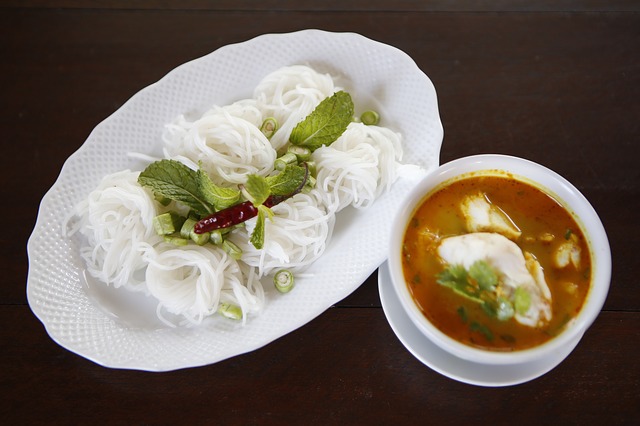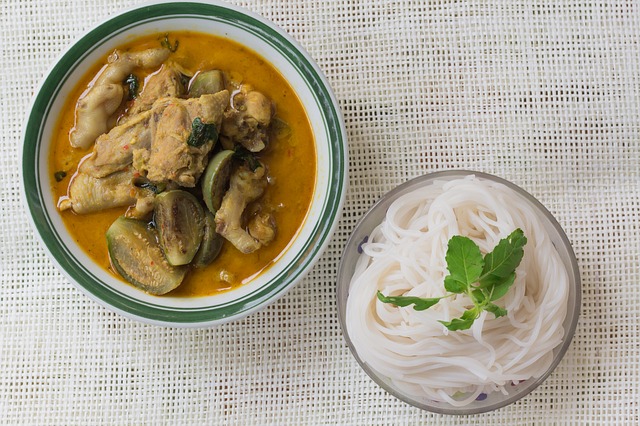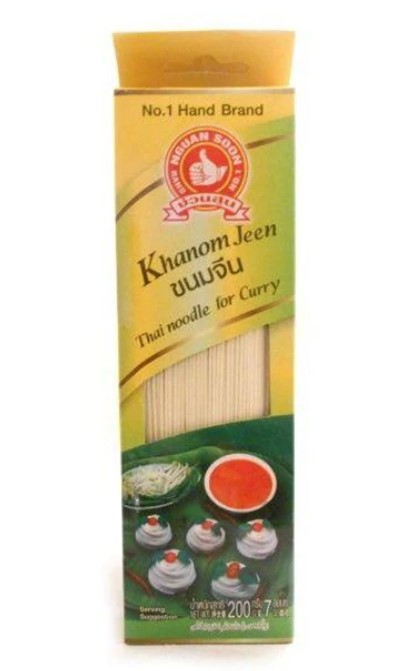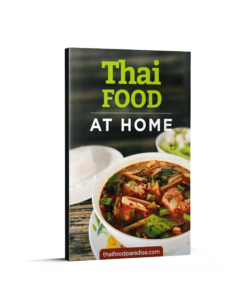All About Kanom Jeen (Fermented Rice Noodles)

When you get really into Thai food, you’ll probably come across dishes with or recipes that call for a uniquely Thai type of noodle. Known as kanom jeen, these delicious rice noodles are an integral part of Thai cuisine. This article explains what they are, what they taste like, how to make them, and what dishes you’ll find them in.
What Are Kanom Jeen?
Kanom jeen are opaque thin pearly white noodles made by fermenting rice for around three days. Popular all over Thailand, locals like eating kanom jeen with a variety of different curries and in salads.
It’s thought that the noodles originated from the Mon ethnic group in Southeast Asia. You can find kanom jeen in many other Southeast Asian countries. it’s likely they first arrived in Thailand anywhere between 700 and 400 years ago.
My first experience with kanom jeen was on my first trip to Chiang Mai. I was drunk after a few beers and I noticed locals flocking to a late-night food cart that had tiny plastic chairs and really low tables.
I took a seat and pointed at what I wanted. Promptly delivered to my table for only 15 baht was a bowl of some of the most delicious noodles I’ve ever eaten. Later I found out it was a northern Thai specialty known as kanom jeen nam ngiao.
The flavour that kanom jeen imparts on a dish is quite unique. They aren’t like your bog-standard flavorless noodles. They have a very noticeable yet simultaneously subtly tangy hit to them, most likely resulting from the fermentation process. The taste is also slightly nutty. The result is a really addictive type of noodle that I love to eat.
How Is Kanom Jeen Used in Thai Food?

Believe it or not, Thai people get bored with eating plain white rice now and then. While it’s their staple carb, sometimes they like to mix things up and eat noodles instead.
You can think of kanom jeen as a replacement for rice in many instances. However, these noodles are also used as an ingredient in salads, meaning they have their own use cases other than being a mere replacement for rice. Here are four dishes you’ll see kanom jeen feature in:
- Green curry: it’s very common for Thais to eat kanom jeen with their famous green curry rather than rice. And believe it or not, it tastes better. The noodles soak up the curry sauce wonderfully, and their slight tartness complements the creamy, spicy curry very well.
- Tam sua: this unique version of papaya salad is scarcely talked about by foreign visitors to Thailand. However, the addition of fermented rice noodles makes for a more substantial and arguably more delicious salad.
- Nam Ya: this delicious curry noodle dish is to Southern Thai people what name ngiao is to Northern Thai people. It’s spicy, fortified with coconuts and all sorts of aromatics. A really tasty, popular dish.
- Tai Pla: One for the hardcore Thai eaters, this popular Southern curry is made from fish entrails. I personally don’t like it but it’s very commonly eaten with fermented rice noodles. Warning: it’s an incredibly spicy dish.
How to Make Kanom Jeen Noodles
It’s an incredibly labor-intensive process to make kanom jeen noodles from scratch in the traditional way. If you are a glutton for either punishment or tradition, check out the fantastic DIY guide over at Thaifoodmaster with pictures and all. Be warned: I didn’t count the steps involved but there must be at least 20, maybe 30.
What’s even more mind-boggling about making these noodles from scratch is that it used to be even more labor-intensive than the guide I linked to. Back in the day, it was required to use an old stone mill to produce the necessary milk starch from the fermented rice in order to form the dough which is used to make the noodles. Thank goodness for technology, hey.
Where to Buy Kanom Jeen Noodles
For everyone else not willing to go to this level of effort, getting freshly made kanom jeen outside of Thailand is obviously not feasible. But you do have some alternatives.
Here in Ireland, I can get dried kanom jeen noodles in specialist Asian grocery stores. I’m assuming the same is also true in the U.S. They taste great and quite close to the fresh version so they’re definitely worth seeking out.
In fact, one seller on Amazon lists a 7.5-ounce packet of fermented Thai rice noodles for a reasonable price if you’d prefer the convenience of ordering online. if you’re looking out for dried fermented noodles at an Asian grocery store, look for those made by a company called the “Hand Brand” like the below image.

Closing Thoughts
If you want to find some recipes in which kanom jeen noodles are used, make sure you check out my main recipes page. This page is updated regularly (twice per month) with new authentic Thai food recipes you can cook from your kitchen.
Have you tried these special Thai fermented rice noodles? What do you think of them? Leave me a comment below. Hopefully, this has been a useful resource for you.
I lived in Thailand for a few years during my 20s during which time I fell in love with Thai food. Along with my Thai partner, I cook and eat tasty Thai dishes 3 or 4 times per week. I’m here to bring you recipes, Thai food tips, and suggested cookware for making Thai food.
